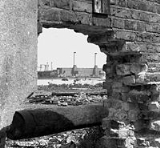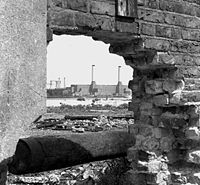
East India Docks
Encyclopedia
The East India Docks was a group of docks in Blackwall
, east London, north-east of the Isle of Dogs
. Today only the entrance basin remains.
which opened in 1802, an Act of Parliament in 1803 set up The East India Dock Company, promoted by the Honourable East India Company
.
The docks were located to the north-east of the West India Docks. They were based on the existing Brunswick Dock, which had been used for fitting out and repairing ships as part of Blackwall Yard
. The Brunswick Dock, which had originally been connected directly to the Thames to the south, became the Export Dock. To the north the company built a larger 18 acres (7.3 ha) Import Dock. Both were connected to the Thames via an eastern entrance basin.
The company was rapidly profitable, with commodities such as tea, spices, indigo, silk and Persian carpets. The tea trade alone was worth £30m a year. The docks spawned further local industry, with spice merchants and pepper grinders setting up around the dock to process goods.
In 1838 the East and West India companies merged. In 1886, in the last act of a ruinous game of leapfrog with the London & St Katharine Dock Company, they built the Tilbury Docks
. In 1909 the docks were taken over by the Port of London Authority
, along with the other enclosed docks.
While much smaller than the West India Docks or the later Royal Docks
, the East India Docks could still handle East Indiamen
of 1000 tons and up to 250 ships at one time. However the advent of steam power and larger ships reduced the importance of this dock and by the mid-20th century most of the trade had left.
The docks played a key role in the Second World War as a location for constructing the floating Mulberry harbour
s used by the Allies to support the D-Day
landings in France.
Following the Second World War, in which all the docks were badly damaged, the East India Docks were confined to occasional Channel Islands
traffic and to the maintenance of dredger equipment etc.
 Brunswick Wharf Power Station
Brunswick Wharf Power Station
was built on the site of the Export Dock in stages between 1946 and 1956. This was a monumental brick structure with fluted concrete chimneys after the style of Gilbert Scott's designs for Battersea
and Bankside
. It ceased generation in 1984 and was demolished in the late 1980s.
The docks were the first London docks to close, in 1967.
Blackwall, London
Blackwall is an area of the East End of London, situated in the London Borough of Tower Hamlets on the north bank of the River Thames.The district around Blackwall Stairs was known as Blackwall by at least the 14th century. This presumably derives from the colour of the river wall, constructed in...
, east London, north-east of the Isle of Dogs
Isle of Dogs
The Isle of Dogs is a former island in the East End of London that is bounded on three sides by one of the largest meanders in the River Thames.-Etymology:...
. Today only the entrance basin remains.
History
Following the successful creation of the West India DocksWest India Docks
The West India Docks are a series of three docks on the Isle of Dogs in London, the first of which opened in 1802. The docks closed to commercial traffic in 1980 and the Canary Wharf development was built on the site.-History:...
which opened in 1802, an Act of Parliament in 1803 set up The East India Dock Company, promoted by the Honourable East India Company
British East India Company
The East India Company was an early English joint-stock company that was formed initially for pursuing trade with the East Indies, but that ended up trading mainly with the Indian subcontinent and China...
.
The docks were located to the north-east of the West India Docks. They were based on the existing Brunswick Dock, which had been used for fitting out and repairing ships as part of Blackwall Yard
Blackwall Yard
Blackwall Yard was a shipyard on the Thames at Blackwall, London, engaged in ship building and later ship repairs for over 350 years. The yard closed in 1987...
. The Brunswick Dock, which had originally been connected directly to the Thames to the south, became the Export Dock. To the north the company built a larger 18 acres (7.3 ha) Import Dock. Both were connected to the Thames via an eastern entrance basin.
The company was rapidly profitable, with commodities such as tea, spices, indigo, silk and Persian carpets. The tea trade alone was worth £30m a year. The docks spawned further local industry, with spice merchants and pepper grinders setting up around the dock to process goods.
In 1838 the East and West India companies merged. In 1886, in the last act of a ruinous game of leapfrog with the London & St Katharine Dock Company, they built the Tilbury Docks
Port of Tilbury
The Port of Tilbury is located on the River Thames at Tilbury in Essex, England. It is the principal port for London; as well as being the main United Kingdom port for handling the importation of paper. There are extensive facilities for containers, grain, and other bulk cargoes. There are also...
. In 1909 the docks were taken over by the Port of London Authority
Port of London Authority
The Port of London Authority is a self-funding public trust established in 1908 by the Port of London Act to govern the Port of London. Its responsibility extends over the Tideway of the River Thames and the authority is responsible for the public right of navigation and for conservancy of the...
, along with the other enclosed docks.
While much smaller than the West India Docks or the later Royal Docks
Royal Docks
The Royal Docks comprise three docks in east London - the Royal Albert Dock, the Royal Victoria Dock and the King George V Dock. They are more correctly called the Royal Group of Docks to distinguish them from the Royal Dockyards, Royal being due to their naming after royal personages rather than...
, the East India Docks could still handle East Indiamen
East Indiamen
An East Indiaman was a ship operating under charter or license to any of the East India Companies of the major European trading powers of the 17th through the 19th centuries...
of 1000 tons and up to 250 ships at one time. However the advent of steam power and larger ships reduced the importance of this dock and by the mid-20th century most of the trade had left.
The docks played a key role in the Second World War as a location for constructing the floating Mulberry harbour
Mulberry harbour
A Mulberry harbour was a British type of temporary harbour developed in World War II to offload cargo on the beaches during the Allied invasion of Normandy....
s used by the Allies to support the D-Day
D-Day
D-Day is a term often used in military parlance to denote the day on which a combat attack or operation is to be initiated. "D-Day" often represents a variable, designating the day upon which some significant event will occur or has occurred; see Military designation of days and hours for similar...
landings in France.
Following the Second World War, in which all the docks were badly damaged, the East India Docks were confined to occasional Channel Islands
Channel Islands
The Channel Islands are an archipelago of British Crown Dependencies in the English Channel, off the French coast of Normandy. They include two separate bailiwicks: the Bailiwick of Guernsey and the Bailiwick of Jersey...
traffic and to the maintenance of dredger equipment etc.

Brunswick Wharf Power Station
Brunswick Wharf Power Station was a coal and oil-fired power station on the River Thames at Blackwall in London...
was built on the site of the Export Dock in stages between 1946 and 1956. This was a monumental brick structure with fluted concrete chimneys after the style of Gilbert Scott's designs for Battersea
Battersea Power Station
Battersea Power Station is a decommissioned coal-fired power station located on the south bank of the River Thames, in Battersea, South London. The station comprises two individual power stations, built in two stages in the form of a single building. Battersea A Power Station was built first in the...
and Bankside
Bankside Power Station
Bankside Power Station is a former oil-fired power station, located on the south bank of the River Thames, in the Bankside district of London. It generated electricity from 1952 to 1981. Since 2000 the station's building has been used to house the Tate Modern art museum.-History:The station was...
. It ceased generation in 1984 and was demolished in the late 1980s.
The docks were the first London docks to close, in 1967.

